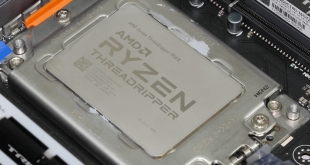
So what are the main features for AMD’s Threadripper CPUs? Firstly, the 12-core 1920X and 16-core 1950X will be available at launch, with the 8-core 1900X coming at the end of August. All CPUs feature AMD’s Simultaneous Multi-Threading (SMT) to double the logical processors available to an OS. An unlocked core ratio multiplier allows the chips to be overclocked. Each chip supports quad-channel memory, including ECC compatibility, and 64 PCIe lanes (60 of which can be used for expansion devices with 4 going to the X399 chipset). They slot into the new TR4 socket which features 4094 pins and is based on the AMD EPYC server processor design.
Focussing more on the 1920X and 1950X CPUs, AMD’s multi-die approach means that these chips are basically a pair of Ryzen 5 1600X (for the 12-core 1920X) or Ryzen 7 1800X (for the 16-core 1950X) CPU dies communicating with each other over Infinity Fabric. That means you get the two 4-core Core Complexes (CCXs) forming each of the dies for the 1950X and the two 3-core CCXs making each of the dies for the 1920X. Given the symmetrical core layout approach deployed by AMD, do not expect to see 10- or 14-core Threadripper chips unless a change of methods is deployed.
This method of creating a multi-die CPU, rather than the largely monolithic approach deployed by Intel, can potentially give AMD a cost advantage for high core count parts. Yields on ‘perfect’ high core count, larger CPUs are naturally lower than those on smaller dies. However, fabbing multiple smaller dies and allowing them to work together can give the high core count end result without the penalty of challenging yields.
That previous multi-die point also explains why Threadripper looks a lot like double a Ryzen 7 or Ryzen 5 chip and half an EPYC processor. That’s basically what it is. And in some respects, that can be a positive. For example, the clock speeds available to Threadripper parts are basically identical to those of the smaller Ryzen chips which is certainly not the case for Intel’s competing Skylake-X/Kaby Lake-X line-up.
AMD is clearly targeting consumers and prosumers with extremely heavy computational requirements. Gamers who want to stream and transcode simultaneously, 3D renderers who need all the CPU cores they can get, tweakers who want multiple high-performance VMs, videographers who need to edit and render high-res video without crippling their system. They are some of the target users for AMD’s Ryzen Threadripper CPUs and the X399 platform as whole.
On the topic of the X399 platform, AMD is taking a different approach to Intel by heavily leveraging on-CPU connectivity resources as opposed to on-chipset options. As such, the X399 chipset only features two general purpose PCIe Gen 3 lanes and eight PCIe 2.0 lanes (compared to up to 24 PCIe 3.0 lanes for X299). Two 10Gbps USB 3.1 Gen 2 and six 5Gbps Gen 1 connections are made available alongside eight SATA 6Gbps links with RAID 0, 1, and 10 support. The Threadripper SoC adds a further eight 5Gbps USB 3.1 Gen 1 connections to the pool as well as four SATA links, should the motherboard vendor choose to deploy them.
However, the CPU is where the real connectivity limelight shines. The 64 PCIe Gen 3 lanes (four of which are reserved for chipset connection) can be used by up to seven PCIe devices natively, or more with the addition of a clock gen. For example, three x16 GPUs and three x4 PCIe NVMe SSDs can be used simultaneously. With 10GbE networking connectivity and high-bandwidth RAID cards in the picture, those PCIe lanes can be eaten quickly.
Unlike Intel’s competition, a user does not have to worry about DMI bottlenecks when using multiple PCIe SSDs. However, Intel now offers VROC to allow for PCIe NVMe SSD RAID linked directly to the CPU. NVMe RAID is not currently supported by the X399 platform, which is undeniably disappointing.
| CPU | AMD Ryzen Threadripper 1950X | AMD Ryzen Threadripper 1920X | Intel Core i9 7900X | AMD Ryzen 7 1800X | Intel Core i7 6950X | Intel Core i7 7700K |
| CPU Codename | Threadripper | Threadripper | Skylake-X | Zen | Broadwell-E | Kaby Lake |
| Core / Threads |
16 / 32 | 12 / 24 | 10 / 20 | 8 / 16 | 10 / 20 | 4 / 8 |
| Base Frequency | 3.4GHz | 3.5GHz | 3.3GHz | 3.6GHz | 3.0GHz | 4.2GHz |
| All-Core Frequency | 3.7GHz | 3.7GHz | 4.0GHz | 3.7GHz | 3.4GHz | 4.4GHz |
| Boost Frequency | 4.0GHz | 4.0GHz | 4.3GHz | 4.0GHz | 3.5GHz | 4.5GHz |
| Maximum Frequency (XFR / TBM 3.0) |
Up to 4.2GHz (XFR, 4 cores) | Up to 4.2GHz (XFR, 4 cores) | Up to 4.5GHz (TBM 3.0, 2 cores) | Up to 4.1GHz (XFR, 2 cores) | Up to 4.0GHz (TBM 3.0, 1 core) | n/a |
| Unlocked Core Multiplier | Yes (x0.25 granularity) | Yes (x0.25 granularity) | Yes (x1 granularity) | Yes (x0.25 granularity) | Yes (x1 granularity) | Yes (x1 granularity) |
| L3 Cache | 32MB | 32MB | 13.75MB | 16MB | 25MB | 8MB |
| Max. Memory Channels |
4 (DDR4) | 4 (DDR4) | 4 (DDR4) | 2 (DDR4) | 4 (DDR4) | 2 (DDR4 & DDR3L) |
| Max. Memory Frequency (Native) |
1866 to 2667MHz | 1866 to 2667MHz | 2666MHz | 1866 to 2667MHz | 2400MHz | 2400MHz / 1600MHz |
| PCIe Lanes | 60+4 | 60+4 | 44 | 16+4+4 | 40 | 16 |
| CPU Socket | TR4 | TR4 | LGA 2066 | AM4 | LGA 2011-3 | LGA 1151 |
| Manufacturing Process | 14nm | 14nm | 14nm | 14nm | 14nm | 14nm |
| TDP | 180W | 180W | 140W | 95W | 140W | 91W |
| MSRP | $999 | $799 | $999 | $499 | $1723-1743 | $339-350 |
| UK Street Price (Aug 2017) |
£999 | £799 | Approx. £860 | Approx. £420 | Approx. £1325 | Approx. £325 |
Looking at the table, $999 to AMD nets you the 16C32T Threadripper 1950X with 60 usable PCIe 3.0 lanes and more L3 cache than Intel’s i9-7900X. However, the $999 Core i9 features higher clock speeds and a lower TDP.
Speaking of TDP, both Ryzen Threadripper parts are rated at a hefty 180W. However, do not confuse TDP with power consumption as the two metrics are only loosely related. What a 180W TDP does say, however, is that you need a hefty cooler to keep the CPUs happy even at stock clocks.
Memory speed support is the same 1866 to 2667MHz as observed with Ryzen 7. AMD validates Threadripper for single-rank DIMMs at 2667MHz for four sticks (1DPC) and 2133MHz for eight sticks (2DPC), while dual-rank DIMMs are 2400MHz for four sticks and 1866MHz for eight sticks. Interestingly, AMD also claims support for up to 512GB of memory per channel, giving 2TB(!) in total. Such numbers will not work on most Windows 10 versions (currently) and will require the use of future higher-capacity UDIMMs.
Ryzen’s L2 cache per core is 512K, giving the 12-core 1920X 6MB total and the 16-core 1950X 8MB total. That’s lower than the 1MB L2 cache per core for Intel’s re-balanced Skylake-X chips. AMD makes up for that with 32MB L3 cache split across the two dies, as opposed to 13.75MB L3 cache for the i9-7900X. AMD’s die-based L3 cache approach gives the 12-core 1920X more L3 cache per core than its 16-core 1920X counterpart.
One point worth noting is the XFR clock speed for both Ryzen Threadripper CPUs. AMD’s previous maximum XFR frequency was 4.1GHz with the Ryzen 7 1800X and Ryzen 5 1600X. AMD has binned the best Ryzen dies and pushed that maximum clock speed up to 4.2GHz but now on 4 cores. In theory, four of Ryzen Threadripper 1920X’s and 1950X’s cores can operate up to 4.2GHz if other thermal and power headroom limitations are met. You still get the same SenseMI technologies as are on all Ryzen CPUs, with Precision Boost still allowing for rapid progression through clock speed states in 25MHz steps.
For more information on the Zen architecture, see our Ryzen 7 1800X launch review HERE. For more information relating specifically to Ryzen Threadripper and its features such as Distributed and Local memory modes, as well as Legacy Compatibility Mode, see our Threadripper announcement coverage HERE. You can watch our unboxing video HERE.
 KitGuru KitGuru.net – Tech News | Hardware News | Hardware Reviews | IOS | Mobile | Gaming | Graphics Cards
KitGuru KitGuru.net – Tech News | Hardware News | Hardware Reviews | IOS | Mobile | Gaming | Graphics Cards


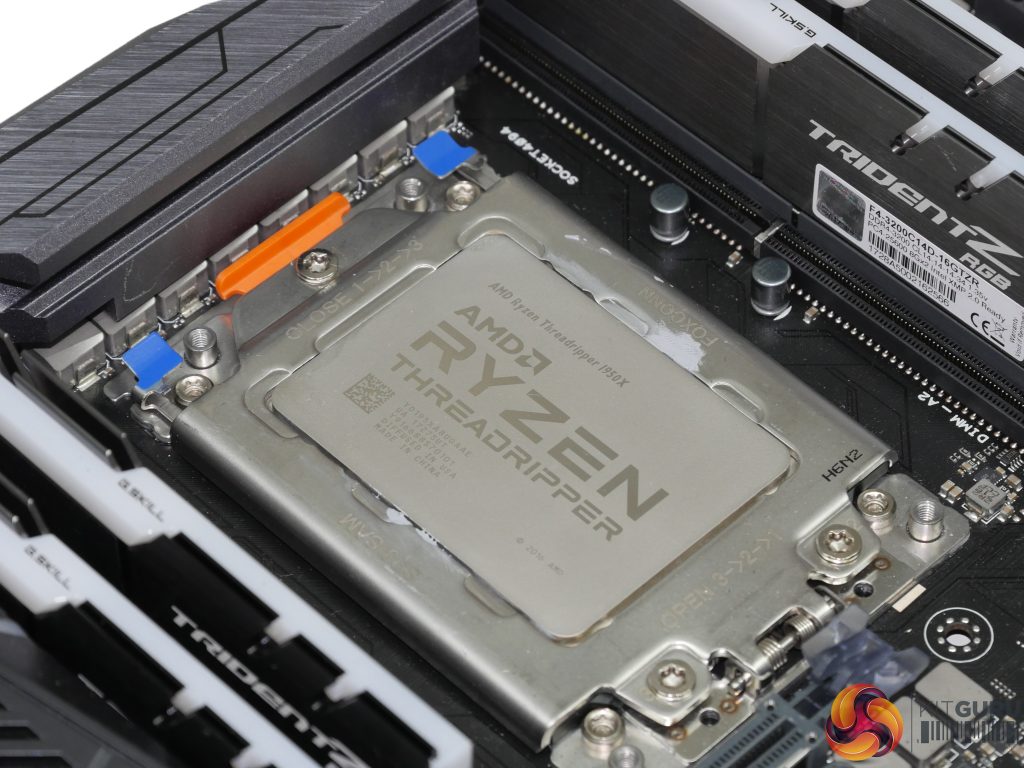
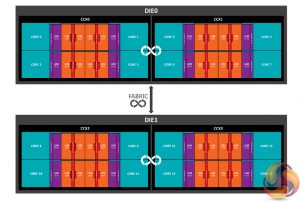
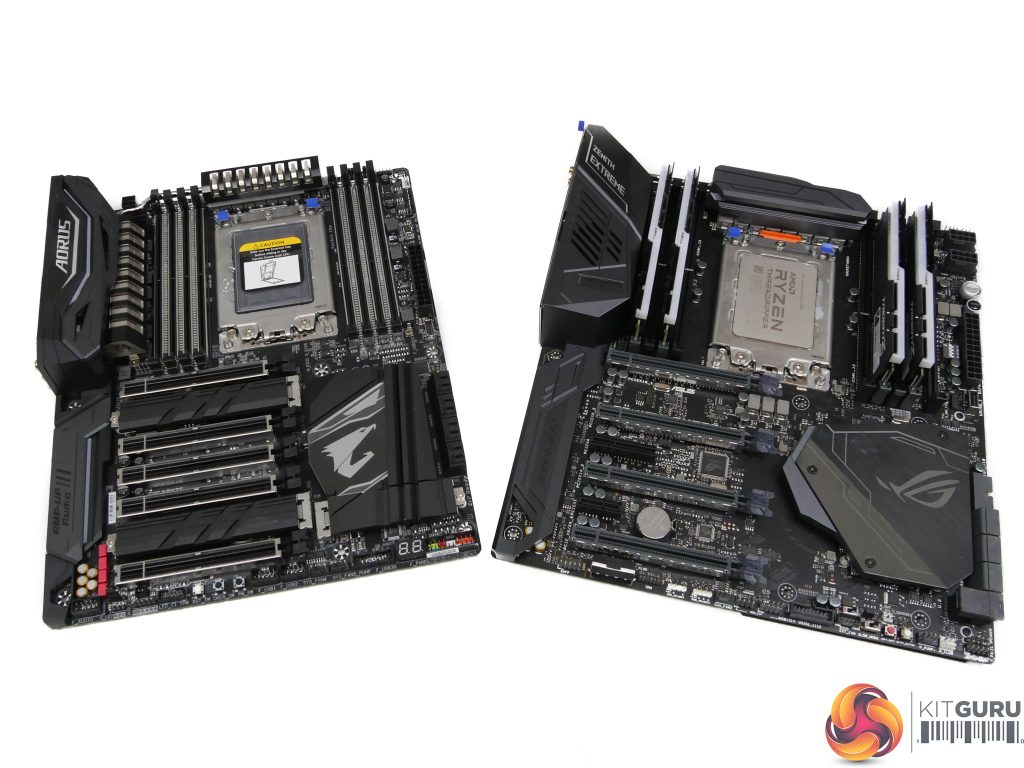
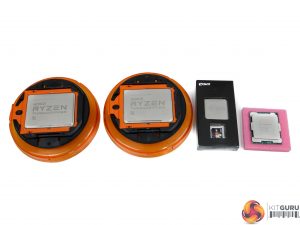
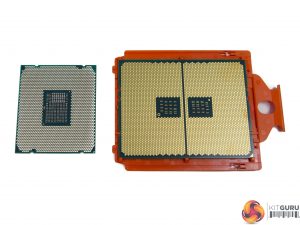
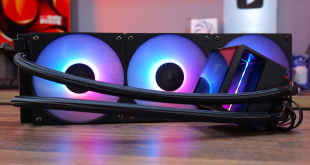
So it’s a beast for productivity [if it’s capable of delivering reliability in the long run], and it’s just fine for gaming, but not as cool as Intel. Not bad, not that great either. No reason to go away from X299 for now. I wonder how will the 12 – 18core Intel fare, both with performance and prices. Great review, proving my point in many discussions, thank You 🙂
so single core comparation is done with intel set at 4.5-5GHz and AMDs at 4.0GHz, and you’re surprised of that Intel’s is better 😐
So to test the maximum overclocked speeds of each you want Luke to achieve a 4.5ghz overclock on the Ryzen even though its just not possible. Perhaps Gandalf can help him with some magical powers.
Yes. All testing is done at stock and the realistic achievable overclocks on each CPU. Throttling Intel back to X GHz would be unfair if the Intel chips can OC further. Just as it would be unfair to throttle back Ryzen CPUs if they have faster clock speeds than their competitors.
Stock and realistic OC frequency is what we always test on all CPUs. Intel’s Skylake-X and Kaby Lake CPUs tend to OC higher than AMD’s Ryzen chips so that’s what people run their frequencies at and that’s what we test with.
Luke
Ok, i get that but …
1. Same cooling was used for both?
2. Is TR restricted, or why can’t it go pass the boosted clocks?
So, considering that AMD again gives 50 and 60 percent more cores for a same or the similar price those CPUs are a beasts for people who need productivity and content creation CPU
Who games at 1080p with a £1000 CPU and a GTX1080 ti? Wasn’t Ryzen equal to its intel equivalent at higher resolutions, Is this the same with ThreadRipper?
“Cons” in the review are so depraved you can not even imagine, and lacking 1 star out of 10…. For what? For not being available for free?
Oxymorons
I have to slightly disagree with the gaming analysis. Many times the reason RYZEN doesn’t perform well in gaming is that game developers still haven’t had enough time to optimize the RYZEN platform. Game developers haven’t had enough time with the AMD RYZEN hardware development kits as of yet.
The same cooling was used for all CPUs (280mm AIO) except Threadripper which used a 360mm Asetek AIO due to mounting compatibility.
The frequency limits for Ryzen look to be related to the manufacturing process technology used by AMD. At its own fabs, Intel looks to have the ability to manufacture dies that can operate at a higher frequency in general.
1080P and a fast GPU helps isolate CPU performance by ensuring no resolution- or GPU-induced bottlenecks are introduced. Our 4K testing shows Ryzen to be far more competitive against Intel when the performance onus is planted more firmly on the GPU.
Ok, thank you. Maybe Threadripper will be able to get higher OCs with some bios updates, how it happened to Ryzen 🙂
Are you confident its not a fabric/zeppelin die limitation rather than the zen core or the ccx?
If that hasnt been eliminated, perhaps raven ridge can shed some light eventually? As i understand it, and given it must be low power for mobile, it will be a single 4 core zen ccx & a single vega gpu on a die like ryzens zeppelin die. Point being, maybe it can clock better in that die form.
Agreed. Irrespective of the amount cooling available, no multi cores CPU would survive a Prime95 stress test on all cores for 30 minutes, let alone 1 hour or more. Prime95 should be taken off the web.
Current rumors predict $1,700 for the 16-core, and $2,000 for the 18-core.
Hey Luke. May I ask how you obtained the all-core turbo frequencies of the 1920X and 1950X? And how confident are you that they are correct? I ask, only because other sources have consistently stated 3.60 GHz for the 1950X. Thank you very much for this in-depth review.
Those are not rumors, they are official Intel pricing, confirmed by multiple outlets and reviewers.
18 core Intel i9 will be $1999.99 (USD)
16 Core Intel i9 will be $1799.99 (USD)
Price v Performance is going AMD’s route, they will end up taking a good portion of the HEDT market with their aggressive pricing and their performance.
“But muh i9 is faster”..
It also has less PCI-E lanes, uses more energy, when overlocked Intel’s 10 core gets hotter than the 16 core AMD, and dollar per dollar is less of a value. This again has been confirmed in testing via many respected hardware outlets/reviewers.
I only have 12 years as an IT professional in hardware management systems, what would I know.
They got the 16 core 1950X to 5.2Ghz on LN2 (Liquid Nitrogen), while that was obviously not representative of real world operations, it did show what can be done.
The issue Intel faces is the technology change that is currently happening where we are switching software from single core/thread ops to multicore and having code recognize the maximum amount of cores possible.
How is this a problem for Intel?
Despite having an immense about of capital to work with an state-of-the-art R&D facilities, Intel’s latest chips have issues with overclocking all cores and remaining efficient. In fact if you look at Intel’s turbo boosts they downclock heavily after 4 cores to keep TDP and energy consumption manageable and competitive. Intel’s biggest weakness is their ability to maximize silicon yields, this is one of the reasons they charge so much for their CPU’s, while AMD’s current approach allows them to scale as they need to with less transistors required on a single die, maximizing yield.
At this current rate I fully expect AMD to release their Zen 2 7nm CPU before Intel gets Cannon Lake (10nm) CPU’s out as AMD is already reporting over 80% yields with 14nm silicon, and anything above 60% yield allows for very competitive prices.
Okay, thanks John. And for the record, yes, I am fully supportive of Threadripper. Intel has been screwing people over for too long.
I’m not sure why you decided to say this, however.
Intel chips are NOT cool. Not even the 91w i5’s. Unless if you think 80c on watercooling for a STOCK i5 Skylake is cool.
Threadripper better as $1k for 16 cores 32 threads when intel like $2k for that. Ya had enough of limitations and greed
Why was enermax aio not used?
I agree. The 16-core 1950X was available on Amazon for $800 not too long ago.
Not as “cool”?, in what sense exactly? as in an over priced haircut kinda cool?
ur obviously a fanboy dick swinger, the only diff. this time u aint playing with the biggest dick.
All reviews out there on the net show Threadripper is faster in basically all productivity apps other than some outdated software that runs better on quads, TR uses less power, has better SMT, has more IO, costs less and has excellent motherboard support.
Wake up from ur delusional dream Bub, just ’cause ur sore that u overpaid for an overvolted stove top cpu that don’t do shit, don’t mean u have to spread ur bull shit propaganda.
Love the 1950x. Runs well at 4.1GHz, and running Prime95 simultaneously w/CPU-Z stress (all cores at 100%), T 105 fps. Other benchmarks show very good performance and durability.